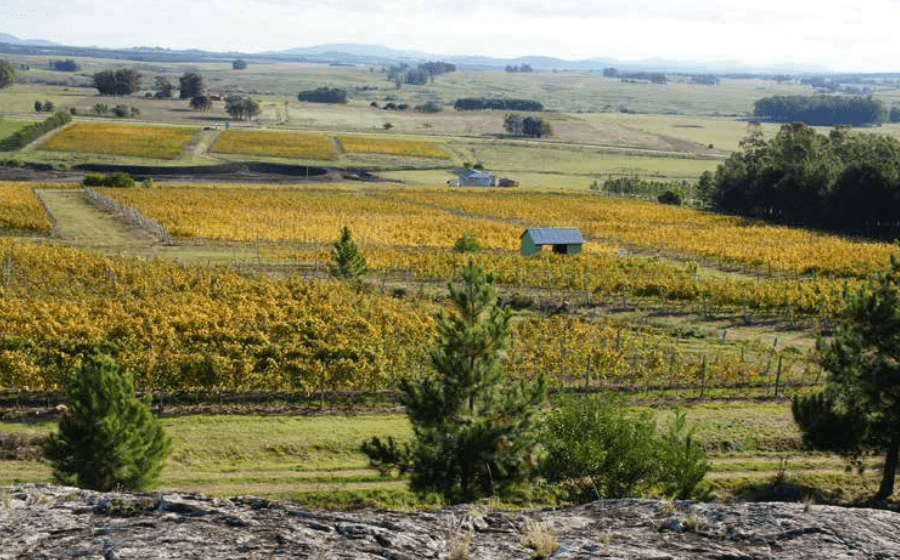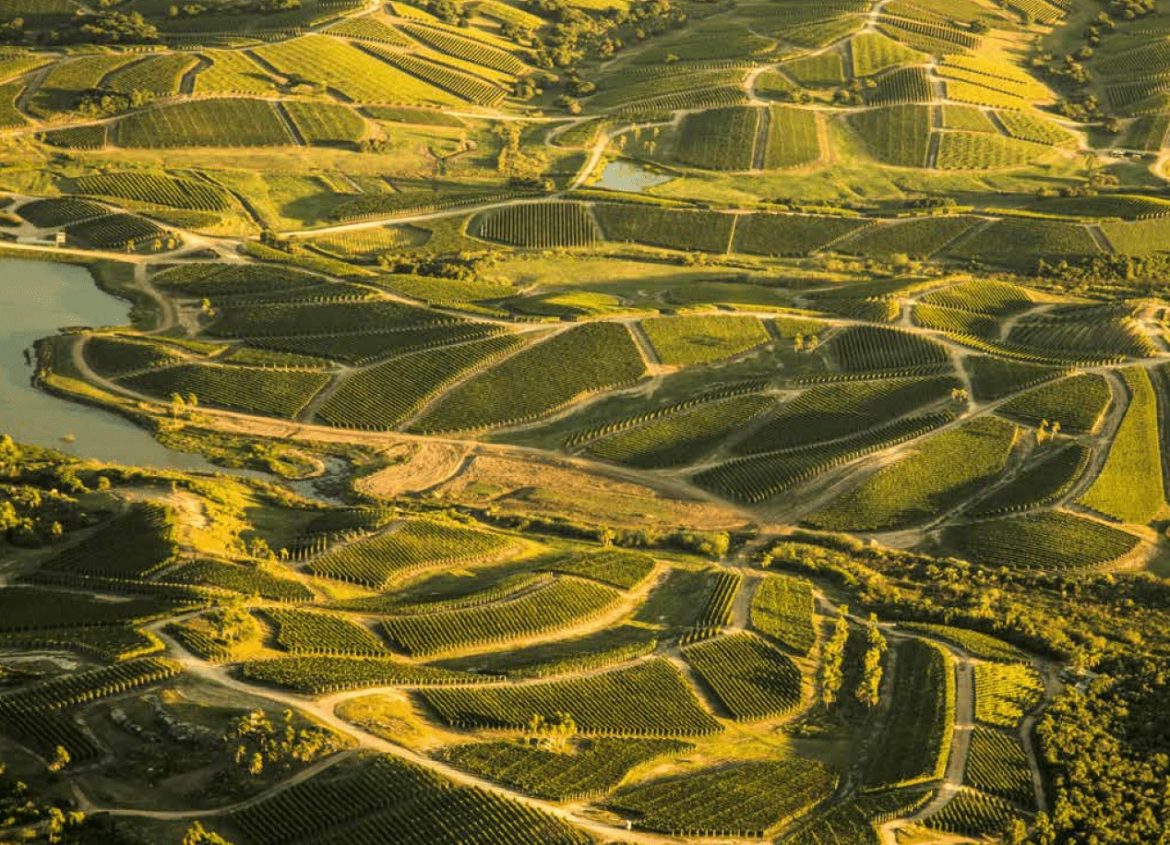Sandwiched between the titans of Brazil and Argentina, Uruguay is undoubtedly small. The country is roughly the size of Greece and has four times more cows than people. But despite its diminutive proportions, wine in Uruguay is a big deal and this small country has the strongest wine culture in Latin America. The highest per capita wine consumers outside Europe, Uruguayans drink 25% more than the Brits and double what Chileans get through. This culture is, in part, what makes Uruguay one of the most exciting South American wine countries today.
Uruguay’s vinous umbilical cord is firmly linked to Europe. In the 1870s, European settlers, mainly of Basque, Catalan and Italian descent, planted vineyards all over the country with grape varieties from their homelands. As wine production shifted from hobby to commerce, the modern wine industry took root conveniently near to the capital city of Montevideo, and the adjacent Canelones region.
Why Tannat is the most important wine in Uruguay
Of the varieties planted, it was the hardy Basque grape Tannat that triumphed – capable of withstanding Uruguay’s 1,300mm annual rainfall and thriving in the heavy soils of Canelones. ‘It has been a survival of the fittest,’ says Christian Wylie, Garzón winery’s general manager. ‘With every other grape variety they would lose a vintage or five! With Tannat you get a decent wine with colour and acidity every year – that’s why it is the most widely planted grape in Uruguay.’
Since then, wine in Uruguay has been synonymous with Tannat and Canelones. But this little country has far more to offer to drinkers today.
The new wines of Uruguay
When the Uruguayan markets opened in the 1980s, it was more than just foreign-made wine that arrived. Flying winemakers and previously unseen technology were brought in to improve production, and the industry was vigorously modernised throughout the 1990s.
‘Our focus changed from growing in volume to growing in quality,’ explains Ana Pizzorno, whose family estate was one of the first to convert to fine wines. With the conversion, winemaking families could replant varieties from their European heritage that had struggled to produce quality results before. The quality of Tannat improved in leaps and bounds, but so did Cabernet Franc, Tempranillo and Marselan, among others.
Perhaps most surprising of all though, for a country whose daily diet was dominated by beef steak and Tannat, it is the whites that are turning heads. ‘The potential of white wines here is huge,’ says Federico de Moura, the current Best Sommelier of Uruguay. ‘We have the weather conditions for good natural acidity – it is much better natural acidity than you find in other southern hemisphere countries where conditions are arid. These wines are fresh and lively, and have ageing potential.’
The country’s Atlantic climate is more reminiscent of Old World than New World, and one of the most promising varieties in recent years is Albariño, whose homeland is the equally rainy Galicia. The spectrum of whites, though, also includes Viognier, Verdejo, Sauvignon Gris, Marsanne and even Arneis.
The expanding and diverse map of Uruguay’s wine regions
As wine varieties in Uruguay are reaching a new dimension, so is the country’s wine map. Ten years ago, 90% of Uruguay’s vineyards were in Canelones, but today the region only represents 60% of plantations. Vineyards are moving into the hills and along the coastline, seeking not only different climates, but distinctive soils.
How diverse are the terroirs of Uruguay? ‘Radical,’ says Paul Hobbs, consultant winemaker for Familia Deicas, which launched Uruguay’s first single-vineyard collection of Tannats. ‘They are anything from heavy clay soils to fractured rock. The sites are extremely diverse, climatically as well as geologically. The wines reflect that. That is one of the exciting things. You go from one to the next and you may as well be in different worlds.’
The different worlds of soil originated in a truly old world – the ancient supercontinent of Pangea. ‘We have very old soils, from the mother rock shared with South Africa,’ says Alfredo Silva, Uruguay’s leading soil expert. ‘We have 99 classified soil groups in Uruguay – a much more varied geology than in neighbouring countries. Uruguay calls your attention because it is very small, but the geological variation is very large.’
This patchwork is now being explored as the potential for new vineyard sites and quality wines is uncovered with the help of new investment pouring into the wine industry.
In the far west, just a stone’s throw from Buenos Aires is Carmelo in Colonia, where Narbona wine estate is the latest foreign investment making characterful wines on the calcareous river bed. Nearby in the hills of Mahoma, schist soils are home to exciting wines being made by Juanicó and Finca Piedra.
But it is further up the coastline in the region of Maldonado where the biggest investment is happening. Uruguayan pioneers such as Alto de la Ballena started making wine there in 1998 and paved the way for new investors from Brazil and Japan. The biggest investment of all though is Argentinian billionaire Alejandro Bulgheroni’s US $100 million wine estate, Garzón. Spotting the potential, he snapped up 8,000 hectares – 217ha of which are already planted with vineyards.

‘Uruguay has an Atlantic Ocean climate, the equivalent of Galicia or Bordeaux, which means quite a lot of rain, so you need a soil with very good drainage,’ says Alberto Antonini, Garzón’s consultant winemaker. ‘Garzón’s vineyards are planted on granite, which is very, very good. I like the energy these granitic soils give to the wine; it is interesting.’
Why Uruguayan wine is a limited edition
Interesting soils are one reason why Uruguay has seen an influx of investment, but it is also down to its relative stability. ‘Uruguay’s economy has performed much better and experienced less volatility than that of neighbouring countries,’ comments Dirk Reinicke, former Latin American director of Deutsche Bank, who invested in El Capricho winery in Durazno. ‘We have a new class of entrepreneurs in Uruguay.’
So why does so little Uruguayan wine make it to export? In this case, size does matter. ‘Uruguay can’t compete at the entry level, as the entire country’s production is smaller than Concha y Toro’s!’ says Nicolas Bonino, export manager for Juanicó. ‘At entry level, our neighbours are very big and very competitive.’
Uruguay will always remain a ‘limited edition’ of South America, but it is that same unique combination of Uruguay’s people and place that make the wines so different. With two excellent vintages (2015 and 2016) being bottled and setting sail across the Atlantic, Uruguayan wine is worth hunting down more than ever.
What are the best wines in Uruguay?
There are so many excellent wines in Uruguay that you should add to your tasting list. Here is a selection of some which will give you a great idea on what’s happening with wine in Uruguay at the moment:
Recommended Uruguayan wines to try
What are the best wines in Uruguay? Here’s a rolling list of some of my favourite Uruguayan wines to try with an assortment of varieties and regions that will give you a good idea of what wine in Uruguay is all about today.
Familia Deicas, Preludio Barrel Select Blanco, Juanicó, Canelones
This barrel-fermented Chardonnay has always been a top Uruguayan white, and since Paul Hobbs joined the crew at Deicas it is even more show-stopping. Complex, balanced and mouthwatering.
Bouza, Albariño, Las Violetas/Melilla, Canelones
It was the whim of Galician descendant Elisa Bouza to plant Albariño, which is now Uruguay’s white variety par excellence. Complex, with a medley of buttery fruit and a long, fresh finish.
Carrau, 1752 Petit Manseng-Sauvignon Gris, Melilla, Canelones
Winemaker Francisco Carrau wants to make Petit Manseng the yin to Tannat’s yang. An intense and rich wine with floral, kumquat and honey notes. One for foie gras.
De Lucca, Reserve Marsanne, El Colorado, Canelones
Reinaldo De Lucca planted his hectare of Marsanne more than 30 years ago and this bold, structured wine has been a staple ever since. Enjoy with stuffed pork.
Garzón, Viognier, Garzón, Maldonado
From the impressive Garzón estate with undulating coastal hills surrounded by forests, this is maritime Viognier. Evokes fresh apricot drizzled with olive oil, leading to a salty, mineral finish.
Pisano, Río de los Pájaros Torrontés, Progreso, Canelones
Elegant white flowers, camomile and green apple characterise this bright white from the Pisano brothers. Unlike Argentinian Torrontés, this has bite! Fresh acidity and a fuller body make it a foodie wine.
Alto de la Ballena, Cetus Syrah, Sierra de la Ballena, Maldonado
On the stony steeps of a whale-spotting lookout, Alto de la Ballena was a pioneer in Maldonado. Forest fruits, flowers and spice on a juicy palate.
Viñedo de los Vientos, Notos, Atlantida, Canelones
Winemaker Pablo Fallabrino is the wild child of Uruguayan wine, and Notos is one wild wine! 90% Nebbiolo and 10% Tannat meet in a flash of red fruit with lip-smacking acidity and tannin.
Garzon Balasto, Maldonado
The first wine in Uruguay to be sold en-primeur, this is the ‘icon’ blend of Garzón in Maldonado with 45% Tannat, 25% Cabernet Franc, 18% Petit Verdot and 12% Marselan. It has nose of vibrant red and black fruit aromas with spice, mineral and floral notes with plenty of energy and tension in the palate. It’s pricey enough (US $150+) you should probably cellar this, but very drinkable in its youth too.
Wine in Uruguay: In numbers
- Uruguay’s wine production: 957,000 hectolitres/year
- 6,562 hectares planted
- 80% red varieties, 20% white
- 3,500 growers (75% <5 ha)
- 90% family-owned
- > 260 wine producers
- Climate in Uruguay: Mild, Atlantic maritime (giving wine in Uruguay a very different profile to other wine regions in South America)
- Rainfall in Uruguay: 850mm – 1250mm rainfall
- Avg. year-round temperature: 16.6° C
